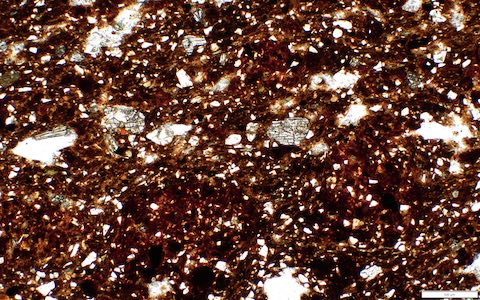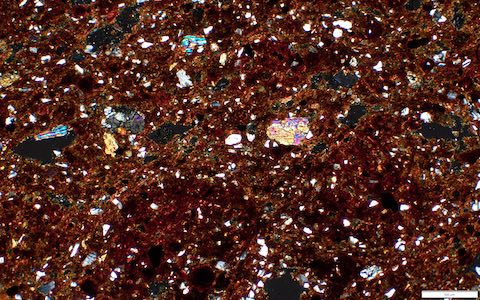Mineral and Rock Abundances
| None (0) | Minor (1) | Few (2) | Common (3) | Frequent (4) | Major (5) | Very Dominant (6) |
| 0% | 0-5% | 5-15% | 15-30 % | 30-50% | 50-70% | 70-100% |
| Name | Cal. | Quartz | Feldspar | Pyroxene | Amphibole | Opaques | Olivine | Biotite | Muscovite | Epidote | Garnet/ Spinel | Ig./Met. Rocks | Sed. Rocks | Grog | Lithics/ Region |
|---|---|---|---|---|---|---|---|---|---|---|---|---|---|---|---|
| Max | 0 | 2 | 3 | 3 | 1 | 2 | 0 | 0 | 0 | 0 | 0 | 2 | 0 | 0 | microlitic, microphaneritic |
| Min | 0 | 2 | 3 | 3 | 1 | 2 | 0 | 0 | 0 | 0 | 0 | 2 | 0 | 0 | PNG |
Representative slides:
| Slide | Site | Possible Origin | Cal. | Quartz | Feldspar | Pyroxene | Amphibole | Opaques | Olivine | Biotite | Muscovite | Epidote | Garnet/ Spinel | Ig./Met. Rocks | Sed. Rocks | Grog | Lithics |
|---|---|---|---|---|---|---|---|---|---|---|---|---|---|---|---|---|---|
| IL_1_68 | Sio (New Guinea) | Sio | 0 | 2 | 3 | 3 | 1 | 2 | 0 | 0 | 0 | 0 | 0 | 2 | 0 | 0 | microlitic, microphaneritic |
IL_1_68


Sio style. CAUTION: Section less than 30microns. Pyroxene grains (<5%) are up to 0.3 mm in length. Angular quartz and feldspar grains make up about 10% of the sherd. These grains are generally small, <0.1 mm but range up to 0.2 mm. Opaque grains, (<5%) are subrounded and up to 0.4 mm in length. There are some minor rock fragments. The clay is red brown.